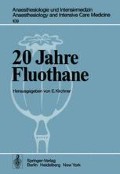Zusammenfassung
Die mögliche Toxizität der von uns verwendeten anaesthetischen Gase und Dämpfe, die chronisch in subanaesthetischen Dosen von einigen ppm bis zu einigen hundert ppm eingeatmet werden, hat in den letzten Jahren eine Flut von klinischen und experimentellen Arbeiten ausgelöst (2, 3, 5,7 ). Wie auch die persönliche Einschätzung dieses Risikos sein mag, eine Verminderung desselben ist ratsam.
Access this chapter
Tax calculation will be finalised at checkout
Purchases are for personal use only
Preview
Unable to display preview. Download preview PDF.
Literatur
BARTON, F., NUNN, J. F.: Totally closed circuit nitrous oxide/oxygen anaesthesia. Brit. J. Anaesth. 47, 350 (1975).
CHENOWETH, M. B., LEONG, B. K. J., SPARSCHU, G. L. et al. : Toxicities of methoxyflurane, halothane and diethylether in laboratory animals on repeated inhalation of subanesthetic concentrations. In: Cellülar biology and toxicity of anesthetics. FINK, B.R. (ed.). Baltimore: Williams and Wilkins 1972.
COHEN, E. N., BROWN, B. W., BRUCE, D. L. et al. : Occupational disease among operating room personal: A national study, Anesthesiology 41, 321 (1974).
HILL, D. W., LOWE, M. J.: Comparison of halothane in closed and semiclosed circuits during controlled Ventilation. Anesthesiology 23, 291 (1962).
KLAN, P. H., HERDEN, H. N., LAWIN, P.: Vergleichende gaschromatographische Untersuchungen der Exspirationsluft von Patienten nach Narkosen mit Enflurane, Halothan und Methoxy fluran. Z. prakt. Anaesth. 10, 356 (1975).
SAIDMAN, L. J., EGER, E. J. II: Effect of nitrous oxide and of narcotic premedication on the alveolar concentration of halothane required for anesthesia. Anesthesiology 25, 302 (1964).
SCHULZE, H. H., KÄSTNER, D., LANGE, P.: Zur Frage der chronischen Toxicität von Halothan-Konzentrationen in der Operationsluft. Anaesthesist 11, 378 (1969).
SEVERINGHAUS, J. W.: In: PAPPER, Em!m, KITZ, R. J.: Uptake and distribution of anesthetic
Editor information
Editors and Affiliations
Rights and permissions
Copyright information
© 1978 Springer-Verlag Berlin Heidelberg
About this chapter
Cite this chapter
Spieß, K.W. (1978). Halothan-Lachgas-Narkose im Geschlossenen System. In: Kirchner, E. (eds) 20 Jahre Fluothane. Anaesthesiologie und Intensivmedizin / Anaesthesiology and Intensive Care Medicine, vol 109. Springer, Berlin, Heidelberg. https://doi.org/10.1007/978-3-642-66862-3_25
Download citation
DOI: https://doi.org/10.1007/978-3-642-66862-3_25
Publisher Name: Springer, Berlin, Heidelberg
Print ISBN: 978-3-540-08602-4
Online ISBN: 978-3-642-66862-3
eBook Packages: Springer Book Archive

